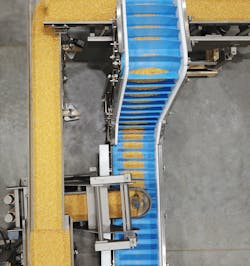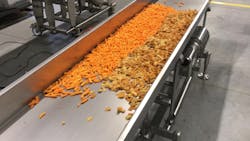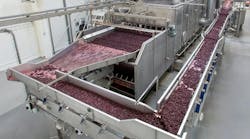Modern food conveyor systems keep products clean, safe and fresh while moving through the facility. Choosing the right handling technology to match a brand’s processing needs can help food processors increase speed and improve flexibility, resulting in better quality products on the shelf.
Horizontal motion and vibratory food conveyor systems offer different solutions to safely and efficiently transport food products through a facility.
Turning that potential into bottom-line gains depends on matching the advantages of the process to a company’s product mix, value proposition and budget.
Considering which might work best for a food processor’s needs includes looking at the following:
- How Do Horizontal Motion Conveyors Work?
- How Do Vibratory Conveyors Work?
- When to Use a Horizontal Motion Conveyor
- When to Use a Vibratory Conveyor
How do horizontal motion conveyors work?
Food-grade horizontal motion conveyors provide steady, gentle, forward movement of food in the desired direction by sliding it down one or more product pans.
Horizontal conveyors are powered by advanced computer-controlled servo motors. These motors generate controlled, consistent forward movement while allowing:
- Infinitely variable speed control
- Instant motion start/stop
- Full motion reversibility
Horizontal motion conveyors can move products up to 40 feet a minute. The equipment requires a flat or slightly inclined material to move material downhill in a controlled way. It can also move product at a decline and a slight incline (usually not more than a 1-degree upward slope).
Here are some of the considerations to keep in mind when evaluating horizontal motion conveyors:
Performance
Horizontal motion conveying is also well suited to extreme operating conditions, including freezer rooms and processes involving the harshest wash-down and sterilization procedures.
Higher-quality direct-drive horizontal motion conveyors are limited in length to about 20 feet per unit. Multiple units can convey material for distances of 60-80 feet, but the cost of moving material per line foot is higher. Some manufacturers can build extended units, but these require large mechanical drives, adding to maintenance costs and potential downtime.
Horizontal motion conveyors can also be run in reverse. This can be useful when slowing or reversing the line is required. For example, allowing the product to be held without stopping the line to replace bagging film.
The steady forward movement of horizontal motion equipment also makes inspecting material on the line easier. It helps keep mixed products together before separation and packaging through a proportion gate.
Horizontal conveyors offer quieter mechanical operation than other transfer or handling solutions, although this also depends on the material being handled.
Sanitation
The sealed direct-drive servo motors used on some equipment protect the most sensitive mechanical components while making more of the unit’s moving parts visible and accessible. Simple design and smooth, threadless construction reduce harboring opportunities and allow easy cleaning and sanitization.
Maintenance
Smart design also makes maintenance easier, while drop-in or toolless replacement of more parts becomes possible. Horizontal motion conveyors can operate faultlessly for many years, although key components like bushings need to be replaced every few years or perhaps more often for conveyors operating in harsh applications.
Cost
Horizontal motion conveyors feature a more sophisticated design and offer greater control over production motion and speed. The up-front expense of design, customization and installation of horizontal motion equipment tends to be higher than vibratory equipment, but maintenance costs over time are generally lower.
How do vibratory conveyors work?
Food-grade vibratory conveyors are driven by mechanical or electromagnetic drives that generate side-to-side agitation along the line. Depending on the product being moved, these can be:
- Long-stroke, lower-frequency mechanical drives for slower, more gentle agitation, or
- Short-stroke high-frequency electromagnetic drives for faster, more aggressive motion
This makes vibratory conveyors a flexible solution for a wide range of food processing applications. Longer-cycling mechanical drives are used when a product can be moved more slowly or to protect fragile foodstuffs. In contrast, higher-frequency electromagnetic drives are used to provide aggressive agitation or to move lighter foodstuffs more quickly.
Consider these factors when evaluating vibratory conveyors:
Performance
Some conveyors can move up to 55 feet a minute, although this depends on the nature of the foodstuffs and the type of drives used by a vibratory conveyor. Multiple units can be used to achieve longer lengths. Pan width varies based on product rates and density.
Vibratory conveyors provide a lot of flexibility in where and how they can be installed. They also offer the ability to move product down relatively steep inclines and up slopes as steep as 7 degrees.
They adapt well to harsh environments, including both hot and freezing conditions. Vibratory equipment tends to be noisier than horizontal motion equipment, but this is determined mainly by the material being handled.
Processing in motion
The real value of vibratory motion conveyors lies in their ability to orient and process product while in motion. By fine-tuning side-to-side agitation to the product being transported, vibratory conveyors can be designed to:
- Orient product for packaging or further processing
- Spread out loose material into a single layer
- Grade product by size
- Screening product to remove material that is too small
- “Scalp” product to take off material that is too big
- Dewater product without drying it
- Lane material for separation
Sanitation
When considering sanitation, look for food-grade vibratory conveyors with features designed to maximize food safety while offer ease of maintenance including:
- No lubrication design and no food-exposed moving parts
- Sealed covers to protect sensitive equipment during wash-down
- Open construction to allow easy maintenance and parts replacement
- Pans that are easy to wipe and wash down
Maintenance
Vibratory conveyors are relatively easy to maintain, although equipment does need to be kept tuned and adjusted to reduce wear and ensure optimum performance. Springs exposed to extreme heat or cold must be replaced regularly.
Cost
In general, the flexibility, higher capacity, and wider availability of vibratory conveyors make them relatively cost-effective to install and run. Conveyors designed to sort and separate products cost more to set up but can add a lot of value to the operation of a facility over time.
When to use a horizontal motion conveyor
Horizontal motion conveyors offer consistent, gentle motion and fine movement control. They feature robust construction and quality materials to deliver long-term performance. While these conveyors may cost more, they also deliver better reliability and sanitation performance.
Horizontal motion equipment offers some key capabilities that make it well suited to handling fragile food products in the final stage of processing:
- Gentle handling ensures seasoning is not knocked off of ready-to-eat foods
- Mixed foods are maintained in the correct proportions
- Horizontal motion lines integrate well with proportion gates used for packaging
- Food on the line can be visually inspected for quality control
Horizontal motion conveyors don’t work as well with food that is processed in the middle of the value chain. This includes:
- Wet products
- Sticky, waxy, or oily foods or products that leave a residue
- Any materials that require separation, screening, or scalping
Instead, horizontal motion conveyor technology works best when well-matched to a processor’s product mix. It is particularly effective for dry, denser, and finer products, or products that mix materials of different sizes and consistencies. It’s also good for handling fragile products, including fresh and frozen produce. Ideal applications for horizontal motion equipment include:
- Soft fruit and vegetables
- High-value frozen seafood
- Baked goods
- Cereals, granola, trail mix
- Ready-to-eat snacks from chips to Chex Mix
When to use a vibratory conveyor
Vibratory conveyors are a cost-effective way to move and process many kinds of products. Vibratory conveyors' versatility, scalability and value-added pre-processing ability make them a go-to solution for many common processing challenges.
Investing in higher-quality vibratory equipment will improve reliability and reduce maintenance. Look for equipment with minimal moving parts and rigid construction, as well as sanitation compliance and protection.
The higher capacity and lower cost-per-foot of vibratory equipment make it a good choice for handling large volumes of material in an operation's receiving and processing phases. It’s effective for dewatering delicate foods to avoid harsh drying processes. It can also be designed to allow oily or fried foods to drain effectively and to prevent sticky foods from adhering to the line.
Vibratory conveying equipment can add tremendous efficiency to a processing operation through these and other value-added applications:
- Orientate product for packaging or further processing
- Spread and pre-sort treated product before drying or compression
- Remove crumbs or clumps from granular products to ensure product consistency
- Separate mixed-grade materials into graded lanes
Vibratory equipment is not well suited to handling delicate or very fine products, or mixed components that need to be kept in specific proportions. It is also difficult to separate specific proportions from a vibrating line for packaging.
Instead, use versatile food-grade vibratory equipment to transfer, sort, and assemble bulk products and prepare wet, oil, or sticky foods for further processing and packing. Ideal applications for vibratory conveyors include:
- Orientating candy or baked goods for individual packaging
- Washing, dewatering, and grading fresh produce like potatoes
- Removing both large clumps and small crumbs from dog kibble
- Remove and reclaim excess water from frozen seafood without drying
- Spreading nuts or grains before roasting or drying
- Draining and cooling fried foods like chicken or donuts
Choose the right equipment to meet the food processor’s specific needs
When determining whether horizontal motion or vibratory conveyor systems are best, consider the company’s specific processing needs.
From critical sanitary safeguards and optimum line efficiency to managing environmental noise, the unique characteristics of the materials affect every part of the conveying process.
Finding equipment with the right mix of performance, safety and efficiency can unlock immediate performance gains and deliver returns on investment for years to come.
Barry Whitman has 30 years of experience in the food processing conveyance industry. As Global Sales Manager at PFI, a Grote Company brand, he works with major food brands to connect their food processing lines with PFI’s conveying and handling equipment and Vanmark and Grote Company’s processing machines. He brings solutions focused on efficiency, uptime, quality, and especially food safety and sanitation to customers.




